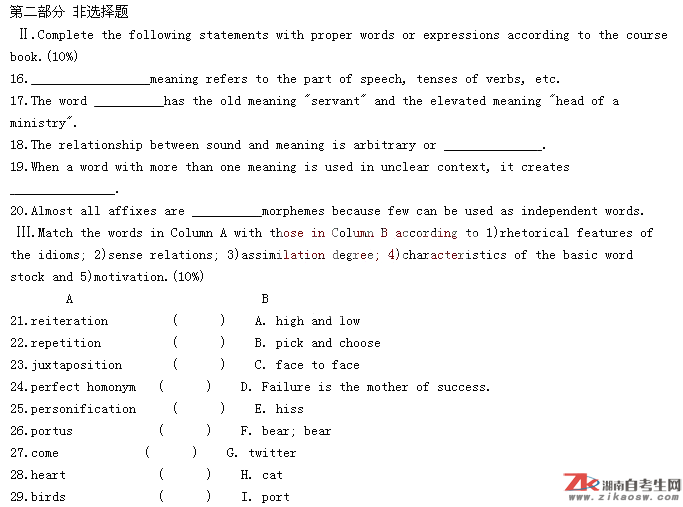注:不同省份、不同专业的自考试题及答案,只要课程代码和课程名称相同,都可参考使用。
更多自考真题资料购买》》》
课程代码:00832
第一部分 选择题
Ⅰ.Each of the statements below is followed by four alternative answers. Choose the one that would best complete the statement and put the letter in the bracket.(30%)
1.According to the degree of similarity, homonyms can be classified into( )
A. perfect homonyms B. homonyms
C. homophones D. all the above
2.Transfer as a mode of semantic change can be illustrated by the example( )
A. ad for “advertisement” B. dish for “food"
C. fond for “affectionate” D. an editorial for “an editorial article"
3.It is a general belief that the meaning does not exist in the word itself, but it rather spreads over( )
A. the reader’s interpretation B. the neighbouring words
C. the writer's intention D. the etymology of the word
4.Which of the following is a prefix of time and order?
A. extra- B. pro-
C. re- D. semi-
5.Which of the following dictionaries is not a specialized dictionary?
A. The Oxford Dictionary of English Etymology
B. Chamber's Encyclopedic English Dictionary
C. Longmont Dictionary of Phrasal Verbs
D. Webster's New Dictionary of Synonyms
6.Which of the following statements is Not true?
A. Reference is the relationship between language and the world.
B. The relationship between a word and its referent is arbitrary.
C. Concept is universal to all men alike.
D. Sense denotes the relationships outside the language.
7.The words which occur before or after a word and may affect its meaning form( )
A. physical context B. grammatical context
C. lexical context D. linguistic context
8."Smith is an architect. He designed World Trade Center. "The clue provided in the context is( )
A. definition B. explanation
C. example D. hyponym
9.The term "vocabulary" is used in different ways because of all the following reasons EXCEPT that( )
A. it can refer to the common core of a language
B. it can refer to the total number of the words in a language
C. it can represent all the words used in a certain historical period
D. it can stand for words in given dialect or field
10.The idiom "a dark horse" is a( )
A. simile B. metaphor
C. metonymy D. personification
11.An idiom differs from a free phrase in that the former is ( ) and the latter is not.
A. structurally changeable B. semantically analyzable
C. structurally fixed D. easily understood
12.We can work out the meaning of heliocentric and geocentric according to( )
A. morphological structure B. relevant details
C. grammatical structure D. physical context
13.What causes the ambiguity of the sentence ”I like Mary better than Janet"? ( )
A. Vocabulary B. Situation
C. Structure D. None of the above
14.Early Modern English refers to the language spoken( )
A. from 1066 to 1500 B. from 1150 to 1500
C. from 1500 to 1700 D. from 1600 to 1800
15.Affixes added to the end of words to indicate grammatical relationships are known as ( )
A. bound roots B. free morphemes
C. inflectional morphemes D. derivational affixes

30.snakes ( ) J. heart and soul
Ⅳ.Study the following words and expressions and identify 1)types of context clues; 2)types of word formation; 3)types of word-meaning changes and 4)rhetorical features of idioms.(10%)
31.making a restatement of a new word or concept in familiar words ( )
32.sitcom ( )
33.the usual amenities such as a pub, a post office and a school ( )
34.form cradle to grave ( )
35.might and main ( )
36.fax ( )
37.disobey,impolite, ( )
38.hussy:"housewife"→"a woman of low morals"( )
39.disease:"discomfort"→"illness"( )
40.fond:"foolish"→"affectionate"( )
Ⅴ.Define the following terms.(10%)
41.dictionary
42.pejoration
43.idioms nominal in nature
44.Germanic
45.allomorph
Ⅵ.Answer the following questions. Your answers should be clear and short. Write your answers in the space given below.(12%)
46.What are the stylistic features of idioms?
47. How would you explain the difference between back formation and suffixation? Give examples to illustrate your point.
48. How do you distinguish inflectional affixes and derivational affixes?
Ⅶ.Analyze and comment on the following. Write your answers in the space given below.(18%)
49.Comment on the following pairs of sentences in terms of superordinate and subordinates.
a. The man said he would come to our school next week.
b. The visiting scholar said he would visit our university next Monday.
50.Analyes the morphological structures of the following words and point out the types of the morphemes.
unbearable, international, ex-prisoner
英语词汇学试题参考答案
课程代码:00832
Ⅰ.Each of the statements below is followed by four alternative answers. Choose the one that would best complete the statement and put the letter in the bracket.(30%)
1.D 2.B 3.B 4.C 5.B
6.D 7.C 8.C 9.A 10.B
11.C 12.A 13.C 14.C 15.C
Ⅱ.Complete the following statements with proper words or expressions according to the course book.(10%)
16. Grammatical 17. minister 18. conventional 19. ambiguity 20. bound
Ⅲ.Match the words in Column A with those in Column B. (10%)
21.B 22.C 23.A 24.F 25.D
26.I 27.H 28.J 29.G 30.E
Ⅳ.Study the following words and expressions and identify 1)types of context clues; 2)types of word formation; 3)types of word-meaning changes and 4)rhetorical features of idioms.(10%)
31.explanation
32.head+head blending
33.hyponymy/hyponym
34.figure of speech; metonymy
35.phonetic manipulation/alliteration
36.back clipping
37.affixation, prefixation or negative prefixes
38.degradation
39.narrowing
40.elevation
Ⅴ.Define the following terms.(10%)
41. Dictionary is a book which presents in alphabetical order the words of a language, with information as to their spelling, pronunciation, meaning usage, etc.
42. Degradation or pejoration of meaning is the opposite of semantic elevation. It is a process whereby words of good origin fall into ill reputation or non-affective words come to be used in derogatory sense.
43.(1)Each idiom has a noun as the key word.
(2)Each functions as a noun/also knows as
noun idioms.
44.a term used to refer to a branch of the Indo-European language family, which consists of English, German, Dutch, etc.
45.one of the variants that realize a morpheme
Ⅵ.Answer the following questions.(12%)
46.(1)Many idioms were created in different professions, so they were trade-or profession-related, colloquial and informal.
(2)Now most become a part of the common core, neither formal nor informal.
(3)There are still many colloquialisms, slang expressions, literary expressions comparatively small in number.
47.A)Suffixation is the formation of new words by adding suffixes to bases.
B)Back-formation is considered to be the opposite process of suffixation; it's the method of creating words by removing the supposed suffixes.
48.Inflectional affixes are affixes (1) attached to the end of words; (2) to indicate grammatical relationships, while derivational affixes are affixes; (3) added to other morphemes; (4) to create new words.
Ⅶ.Answer the following questions. Your answers should be clear and short Write your answers in the space given below.(18%)
49.要点:
Superordinate Subordinate
1) man scholar
2) come visit
3) school university
4) week Monday
50.
1)Each of the three words consists of three morphemes unbearable(un+bear+able), international (inter+nation+al), ex-prisoner(er+prison+er).
2)Of the nine morphemes, only bear, nation and prison are free morphemes as they can exist by themselves.
3)All the rest un-,-able,inter-,-al, ex-and-er are bound as none of them can stand alone as words.
以上历年真题试卷及答案由湖南自考生网http://www.zikaosw.com/收集、提供。希望能够帮助同学们更好地将书本上的知识与实际案例联系起来,通过真题练习在考试时取得更好地成绩!
TEL:蒋老师17773102705
扫一扫下方二维码关注湖南自考生网微信公众号、客服咨询号,即时获取湖南自考、成考、网教最新考试资讯。

关注公众号免费拿资料

微信扫一扫咨询

微信扫一扫咨询

1、鉴于各方面资讯时常调整与变化,本网所提供的信息仅供参考,实际以考试院通知文件为准。
2、本网部分内容来源于网络,如有内容、版权等问题请与本网联系,我们将会及时处理。联系方式 :QQ(393848300)
3、如转载湖南自考生网声明为“原创”的内容,请注明出处及网址链接,违者必究!